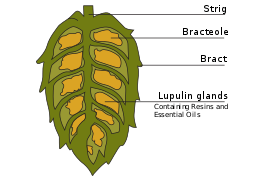**Historical Background of Hops:**
– First documented hop cultivation in 736 in Hallertau, Germany
– Mention of hops in brewing in Germany in 1079
– Hop gardens left to Cloister of Saint-Denis in 768
– Hops challenging gruit in the 13th century
– Introduction of hopped beer in England from Holland around 1400
**Hops Cultivation and Production:**
– Concentrated in moist temperate climates
– Major production areas near the 48th parallel north
– Leading production centers: Hallertau in Germany, Yakima and Willamette valleys in the US
– UK production centers in Kent, Herefordshire, and Worcestershire
– All harvested hops used in beer making
**Chemical Composition and Brewing Process:**
– Hops consist of water, cellulose, proteins, alpha acids, beta acids, essential oils, and flavonoids
– Alpha acids crucial for the bitter taste of beer
– Beta acids contribute to beer aroma
– Essential oils contain terpene hydrocarbons like myrcene, humulene, and caryophyllene
– Brewing process involves drying hops, boiling wort with hops, and fermentation with yeast
**Varieties and Uses of Hops:**
– Various hop varieties used in brewing
– Noble hops like Hallertau, Spalt, Tettnang, and Žatec (Saaz)
– Used in herbal teas, soft drinks, and culinary dishes
– Medicinal uses including sedative effects and potential in hormone replacement therapy
– Different hop varieties contribute unique flavors and aromas to beer
**Global Impact, Health Benefits, and Safety Concerns:**
– Sedative effects and potential health benefits of hops
– International hop industry associations and conventions
– Safety concerns related to hop toxicity, especially to animals like dogs
– Historical and modern uses of hops in brewing, agriculture, and traditional medicine
– Importance of understanding and managing the risks associated with hop consumption
Hops are the flowers (also called seed cones or strobiles) of the hop plant Humulus lupulus, a member of the Cannabaceae family of flowering plants. They are used primarily as a bittering, flavouring, and stability agent in beer, to which, in addition to bitterness, they impart floral, fruity, or citrus flavours and aromas. Hops are also used for various purposes in other beverages and herbal medicine. The hops plants have separate female and male plants, and only female plants are used for commercial production. The hop plant is a vigorous, climbing, herbaceous perennial, usually trained to grow up strings in a field called a hopfield, hop garden (in the South of England), or hop yard (in the West Country and United States) when grown commercially. Many different varieties of hops are grown by farmers around the world, with different types used for particular styles of beer.




The first documented use of hops in beer is from the 9th century, though Hildegard of Bingen, 300 years later, is often cited as the earliest documented source. Before this period, brewers used a "gruit", composed of a wide variety of bitter herbs and flowers, including dandelion, burdock root, marigold, horehound (the old German name for horehound, Berghopfen, means "mountain hops"), ground ivy, and heather. Early documents include mention of a hop garden in the will of Charlemagne's father, Pepin the Short.
Hops are also used in brewing for their antibacterial effect over less desirable microorganisms and for purported benefits including balancing the sweetness of the malt with bitterness and a variety of flavours and aromas. It is believed that traditional herb combinations for beers were abandoned after it was noticed that beers made with hops were less prone to spoilage.
